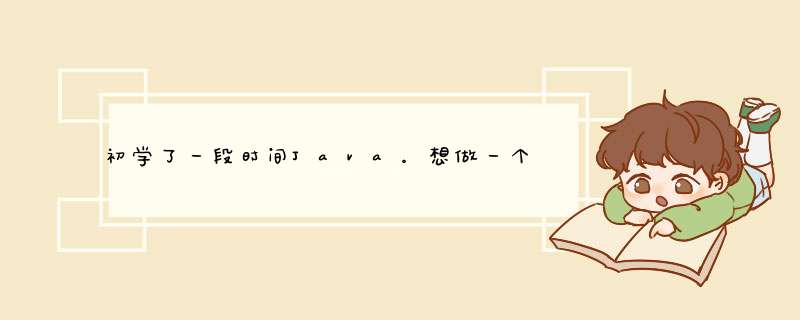
使用javafx的Media,MediaPlayer,MediaView。代码如下:
import javaioFile;import javafxapplicationApplication;
import javafxbeansbindingBindings;
import javafxbeanspropertyReadOnlyProperty;
import javafxbeansvalueObservableValue;
import javafxeventActionEvent;
import javafxgeometryPos;
import javafxsceneScene;
import javafxscenecontrolButton;
import javafxscenecontrolMenu;
import javafxscenecontrolMenuBar;
import javafxscenecontrolMenuItem;
import javafxscenecontrolSlider;
import javafxsceneimageImage;
import javafxsceneimageImageView;
import javafxscenelayoutBorderPane;
import javafxscenelayoutHBox;
import javafxscenelayoutPane;
import javafxscenelayoutVBox;
import javafxscenemediaMedia;
import javafxscenemediaMediaPlayer;
import javafxscenemediaMediaPlayerStatus;
import javafxscenemediaMediaView;
import javafxstageFileChooser;
import javafxstageFileChooserExtensionFilter;
import javafxstageStage;
import javafxutilDuration;
public class App extends Application {
private MediaView mediaView;
private Slider processSlider;
private static final Object AUTO = new Object(), MANUAL = new Object();
public static void main(String[] args) {
launch(args);
}
@Override
public void start(Stage primaryStage) throws Exception {
primaryStagesetTitle("javafx视频播放器");
BorderPane root = new BorderPane();
// 菜单栏
initMenu(root);
// 视频播放控件
mediaView = initMediaView(root);
// 视频功能控件
initMediaControllView(root);
primaryStagesetScene(new Scene(root, 600, 400));
primaryStagesetOnCloseRequest(event -> Systemexit(0));
primaryStageshow();
}
private MenuBar initMenu(final BorderPane parent) {
Menu menu = new Menu("菜单");
MenuItem item = new MenuItem("打开");
itemsetOnAction(event -> {
FileChooser chooser = new FileChooser();
choosersetTitle("选择视频文件");
choosergetExtensionFilters()add(new ExtensionFilter("视频文件", "mp4", "flv"));
File file = choosershowOpenDialog(parentgetScene()getWindow());
if (file != null) {
MediaPlayer player = mediaViewgetMediaPlayer();
// 关闭当前的player
if (player != null) {
playerstop();
playerdispose();
}
processSlidersetValue(0);
// 创建一个新的player并自动播放
player = new MediaPlayer(new Media(filetoURI()toString()));
playercurrentTimeProperty()addListener(this::mediaProcessChanged);
playersetAutoPlay(true);
mediaViewsetMediaPlayer(player);
}
});
menugetItems()add(item);
item = new MenuItem("退出");
itemsetOnAction(event -> parentgetScene()getWindow()hide());
menugetItems()add(item);
MenuBar menuBar = new MenuBar(menu);
parentsetTop(menuBar);
return menuBar;
}
private MediaView initMediaView(final BorderPane parent) {
MediaView view = new MediaView();
Pane pane = new Pane(view);
parentsetCenter(pane);
// 视频宽高可随着窗口变化而自动缩放
viewfitWidthProperty()bind(BindingsselectDouble(viewparentProperty(), "width"));
viewfitHeightProperty()bind(BindingsselectDouble(viewparentProperty(), "height"));
viewsetPreserveRatio(true);
return view;
}
private void initMediaControllView(final BorderPane parent) {
VBox bottom = new VBox(10);
bottomsetAlignment(PosCENTER);
parentsetBottom(bottom);
Slider slider = new Slider(0, 100, 0);
slidervalueProperty()addListener(this::processSliderChanged);
// slidersetOnMouseClicked(this::processSliderClicked);
bottomgetChildren()add(slider);
processSlider = slider;
HBox hbox = new HBox(10);
bottomgetChildren()add(hbox);
hboxsetAlignment(PosCENTER);
Button btn = new Button(null, new ImageView(loadImage("pausepng")));
btnsetOnAction(this::pauseOrPlay);
hboxgetChildren()add(btn);
btn = new Button(null, new ImageView(loadImage("stoppng")));
btnsetOnAction(this::stopPlay);
hboxgetChildren()add(btn);
}
private static Image loadImage(String resPath) {
return new Image(ThreadcurrentThread()getContextClassLoader()getResourceAsStream(resPath));
}
private void pauseOrPlay(ActionEvent event) {
MediaPlayer player = mediaViewgetMediaPlayer();
if (player == null) {
return;
}
Status status = playergetStatus();
if (status == StatusREADY || status == StatusPAUSED) {
playerplay();
((Button) eventgetTarget())setGraphic(new ImageView(loadImage("pausepng")));
} else if (status == StatusPLAYING) {
playerpause();
((Button) eventgetTarget())setGraphic(new ImageView(loadImage("playpng")));
}
}
private void stopPlay(ActionEvent event) {
MediaPlayer player = mediaViewgetMediaPlayer();
if (player == null) {
return;
}
playerstop();
}
// private void processSliderClicked(MouseEvent event) {
// Slider slider = (Slider) eventgetSource();
// if (mediaViewgetMediaPlayer() != null) {
// Duration d = mediaViewgetMediaPlayer()getTotalDuration()multiply(slidergetValue() / slidergetMax());
// mediaViewgetMediaPlayer()seek(d);
// }
// }
private void processSliderChanged(ObservableValue< extends Number> observable, Number oldValue, Number newValue) {
Slider slider = (Slider) ((ReadOnlyProperty< extends Number>) observable)getBean();
if (slidergetUserData() == AUTO) { // 进度条是自动改变的,因此不用设置播放器
slidersetUserData(null);
return;
}
if (mediaViewgetMediaPlayer() != null) {
slidersetUserData(MANUAL);
Duration d = mediaViewgetMediaPlayer()getTotalDuration()multiply(newValuedoubleValue() / slidergetMax());
mediaViewgetMediaPlayer()seek(d);
}
}
private void mediaProcessChanged(ObservableValue< extends Duration> observable, Duration oldValue, Duration newValue) {
if (processSlidergetUserData() == MANUAL) { // 手动点击进度条
processSlidersetUserData(null);
return;
}
MediaPlayer player = (MediaPlayer) ((ReadOnlyProperty< extends Duration>) observable)getBean();
processSlidersetUserData(AUTO);
processSlidersetValue(newValuetoMillis() / playergetTotalDuration()toMillis() 100);
}
}
对声音媒体的直接支持可以说是Java的一大特色,尤其是在动画中配上声音效果,就可以使人在视觉上和听觉上均得到美的享受,那才叫过瘾。Java中播放声音文件与显示图像文件一样方便,同样只需要先将声音文件装载进来,然后播放就行了。
Java目前支持的声音文件只有一种格式,那就是SUN公司的AU格式(AU文件),也称为u-law格式。由于AU格式的声音仅有8KHz的采样频率且不支持立体声效果,所以音质不算太好。唯一的好处就是AU声音文件的尺寸比其它格式小,有利于网上传输。一般,我们较熟悉的大都是WAV格式的声音文件,因此必须先将它们转换为AU格式(可以选用Goldwave软件来进行这种格式转换)。
声音文件准备好以后,就可以考虑将它装载进来并播放。在Applet类中提供的play( )方法可以将声音文件的装载与播放一并完成,其调用格式如下:
void play(URL url)
void play(URL url, String name)
可见,play( )方法的调用格式与getImage( )方法是完全一样的,也采用URL来定位声音文件。例如,某声音文件audioau与applet文件存放在同一目录下,可以这样写:
play(getCodeBase( ),"audioau");
一旦play( )方法装载了该声音文件,就立即播放。如果找不到指定URL下的声音文件,play( )方法不返回出错信息,只是听不到想听的声音而已。
由于play( )方法只能将声音播放一遍,若想循环播放某声音作为背景音乐,就需要用到功能更强大的AudioClip类,它能更有效地管理声音的播放 *** 作。因为它被定义在javaapplet程序包中,所以使用该类的话,不要忘了在程序头部加上:
import javaappletAudioClip;
为了得到AudioClip对象,我们可以调用Applet类中的getAudioClip( )方法。它能装载指定URL的声音文件,并返回一个AudioClip对象,其调用格式如下:
AudioClip getAudioClip(URL url)
AudioClip getAudioClip(URL url, String name)
得到AudioClip对象以后,就可以调用AudioClip类中所提供的各种方法来 *** 作其中的声音数据,这些方法如表4-4所示。
如果getAudioClip( )方法没有找到所指定的声音文件,就会返回null值。所以,在调用表4-4中所列的方法前,应该先检查一下得到的AudioClip对象不是null,因为在null对象上调用上述方法将导致出错。
如果需要的话,我们还可以在applet中同时装载几个声音文件来一起播放,到时候,这些声音将混合在一起,就象二重奏一样。另外还有一点要说明的是,如果我们使用AudioClip对象的loop( )方法来重复播放背景音乐时,千万不要忘记在适当的时候调用AudioClip对象的stop( )方法来结束放音,否则的话,即使用户离开这一Web页面,该声音也不会停止,这无疑将会惹恼用户。因此,一般我们都在applet的stop( )方法中添上停止播放的代码。
例如,下面这段程序将播放两段声音,一段是连续播放的背景音乐,另一段是讲话录音。
import javaappletAudioClip;
public class Audios extends javaappletApplet{
AudioClip bgmusic,speak;
public void init(){
bgmusic=getAudioClip(getDocumentBase(),"spaceau");
speak=getAudioClip(getDocumentBase(),"introau");
}
public void start(){
if(bgmusic!=null)
bgmusicloop();
if(speak!=null)
speakplay();
}
public void stop(){
if(bgmusic!=null)
bgmusicstop(); //关闭背景音乐,切记。
}
}
package comhongyuantest;
import javaioFile;
import javaioIOException;
import javaxsoundsampledAudioFormat;
import
javaxsoundsampledAudioInputStream;
import
javaxsoundsampledAudioSystem;
import
javaxsoundsampledDataLine;
import
javaxsoundsampledLineUnavailableException;
import
javaxsoundsampledSourceDataLine;
import
javaxsoundsampledUnsupportedAudioFileException;
public class MusicTest {
public static final String MUSIC_FILE = "相逢一笑wav";
public static void main(String[] args) throws
LineUnavailableException,
UnsupportedAudioFileException, IOException {
// 获取音频输入流
AudioInputStream audioInputStream =
AudioSystem
getAudioInputStream(new File(MUSIC_FILE));
//
获取音频编码对象
AudioFormat audioFormat = audioInputStreamgetFormat();
// 设置数据输入
DataLineInfo dataLineInfo = new
DataLineInfo(SourceDataLineclass,
audioFormat,
AudioSystemNOT_SPECIFIED);
SourceDataLine sourceDataLine =
(SourceDataLine)
AudioSystem
getLine(dataLineInfo);
sourceDataLineopen(audioFormat);
sourceDataLinestart();
/
从输入流中读取数据发送到混音器
/
int count;
byte tempBuffer[]
= new byte[1024];
while ((count = audioInputStreamread(tempBuffer, 0,
tempBufferlength)) != -1) {
if (count > 0)
{
sourceDataLinewrite(tempBuffer, 0, count);
}
}
//
清空数据缓冲,并关闭输入
sourceDataLinedrain();
sourceDataLineclose();
}
}
你好!我们所说的mp4仅仅只是一种视频封装格式,里面的视频流却有各种编码格式!就像瓶子装水一样,“瓶子”有各种形状,如mp4 avi wmv rmvb等等…而其中装的是什么液体就不一定了!所以,看似都是mp4文件,它的编码格式可能是H246编码,也可能是
Java可以使用第三方Java Media Framework(JMF)库来判断视频是否可播放,JMF支持多种视频格式,可以通过JMF的Player对象的getDuration()方法来判断视频是否可播放,如果getDuration()方法返回的值大于0,则说明视频是可播放的,反之则不可播放。步骤如下:
1、通过URL构造一个MediaLocator对象;
2、创建一个Player对象;
3、通过调用Player对象的getDuration()方法,判断视频是否可播放;
4、如果可以播放,调用Player对象的start()方法开始播放;
5、调用Player对象的stop()方法结束播放;
6、关闭Player对象。
以上就是关于初学了一段时间Java。想做一个应用程序,程序只需要播放一个本地视频,MP4格式,求教怎么做全部的内容,包括:初学了一段时间Java。想做一个应用程序,程序只需要播放一个本地视频,MP4格式,求教怎么做、java如何播放声音、谁知道如何用纯JAVA代码播放视频文件(可以播放一种视频文件,如mp4,就可以了)等相关内容解答,如果想了解更多相关内容,可以关注我们,你们的支持是我们更新的动力!
欢迎分享,转载请注明来源:内存溢出

 微信扫一扫
微信扫一扫
 支付宝扫一扫
支付宝扫一扫
评论列表(0条)